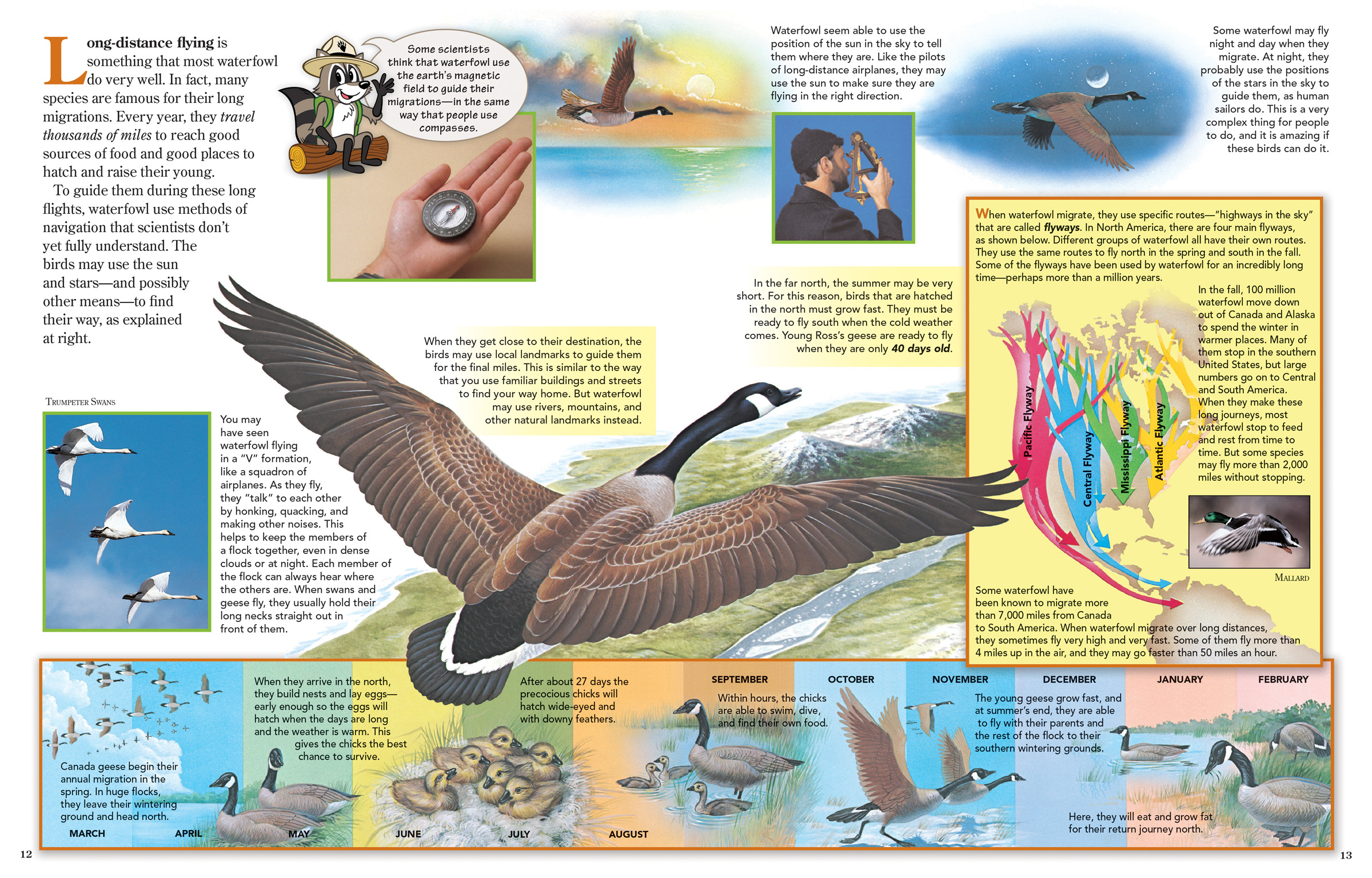
Most Waterfowl Fly Long Distances Very Well
ByLong-distance flying is something that most waterfowl do very well. In fact, many species are famous for their long migrations. Every year, they travel thousands of miles to reach good sources of food and good places to hatch and raise their young.
To guide them during these long flights, waterfowl use methods of navigation that scientists don’t yet fully understand. The birds may use the sun and stars—and possibly other means—to find their way, as explained at right.
Some scientists think that waterfowl use the earth’s magnetic field to guide their migrations—in the same way that people use compasses.
When they get close to their destination, the birds may use local landmarks to guide them for the final miles. This is similar to the way that you use familiar buildings and streets to find your way home. But waterfowl may use rivers, mountains, and other natural landmarks instead.
You may have seen waterfowl flying in a “V” formation, like a squadron of airplanes. As they fly, they “talk” to each other by honking, quacking, and making other noises. This helps to keep the members of a flock together, even in dense clouds or at night. Each member of the flock can always hear where the others are. When swans and geese fly, they usually hold their long necks straight out in front of them.
Waterfowl seem able to use the position of the sun in the sky to tell them where they are. Like the pilots of long-distance airplanes, they may use the sun to make sure they are flying in the right direction.
Some waterfowl may fly night and day when they migrate. At night, they probably use the positions of the stars in the sky to guide them, as human sailors do. This is a very complex thing for people to do, and it is amazing if these birds can do it.
In the far north, the summer may be very short. For this reason, birds that are hatched in the north must grow fast. They must be ready to fly south when the cold weather comes. Young Ross’s geese are ready to fly when they are only 40 days old.
When waterfowl migrate, they use specific routes—“highways in the sky” that are called flyways. In North America, there are four main flyways, as shown below. Different groups of waterfowl all have their own routes. They use the same routes to fly north in the spring and south in the fall. Some of the flyways have been used by waterfowl for an incredibly long time—perhaps more than a million years.
In the fall, 100 million waterfowl move down out of Canada and Alaska to spend the winter in warmer places. Many of them stop in the southern United States, but large numbers go on to Central and South America. When they make these long journeys, most waterfowl stop to feed and rest from time to time. But some species may fly more than 2,000 miles without stopping.
Some waterfowl have been known to migrate more than 7,000 miles from Canada to South America. When waterfowl migrate over long distances, they sometimes fly very high and very fast. Some of them fly more than 4 miles up in the air, and they may go faster than 50 miles an hour.
Canada geese begin their annual migration in the spring. In huge flocks, they leave their winterin ground and head north.
When they arrive in the north, they build nests and lay eggs—early enough so the eggs will hatch when the days are long and the weather is warm. This gives the chicks the best chance to survive.
After about 27 days the precocious chicks will hatch wide-eyed and with downy feathers.
Within hours, the chicks are able to swim, dive, and find their own food.
The young geese grow fast, and at summer’s end, they are able to fly with their parents and the rest of the flock to their southern wintering grounds.
Here, they will eat and grow fat for their return journey north.

